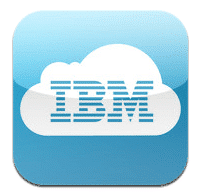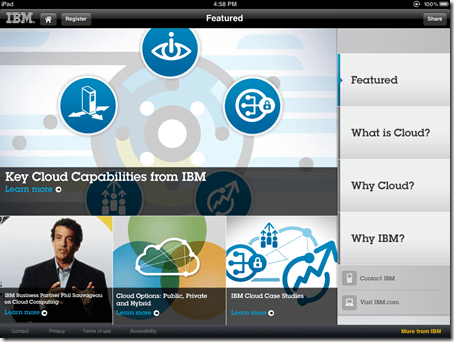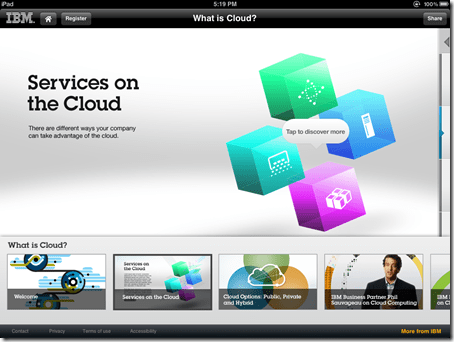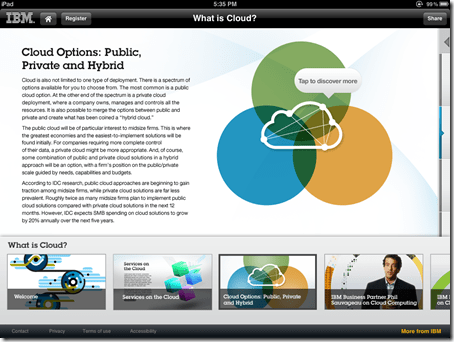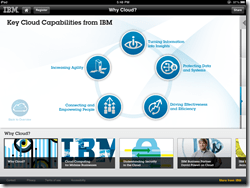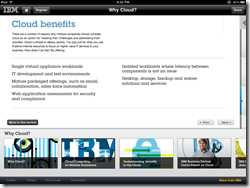
Let me address the 3rd point first. So while this is a sponsored post, the ideas and analysis of the IBM iPad application are entirely mine, and not subject to the approval or editing of IBM. There, I said it. Rest assured that I will analyze this application with the same non-biased seriousness that I do with any other application or software or product that passes my desk.
When I heard that IBM had created a cloud application, my thoughts were immediately that they had crafted a management console to allow you to control IBM-based infrastructure or servers. But once I launched the application, I realized that it was more properly designed as a tool to educate an end-user on what cloud is and the capabilities that IBM can provide to businesses.
The most important start to any cloud project or implementation is that of education. Let’s face it, you wouldn’t buy a car without doing some sort of research first. And, obviously, if you are reading this article, you are probably doing some deeper dives into cloud computing to understand the best practices on how to proceed. (Be sure to read some of my other IBM-sponsored content here that can help with that education process.)
It seems to me that IBM took this approach in compiling their cloud computing education application as they have both IBM-generated and 3rd party content in the form of articles, animations and videos. So, does this format work for cloud education, and how is the content? Read on!
The application is broken out into a series of categories:
- Featured content
- “What is Cloud?”
- “Why Cloud?”
- “Why IBM?
Each section is made of of different types of content which is, in turn, broken into various sub-sections. The first time through, a user might get a bit caught up within the multiple sections and sub-sections, but you can always return to the main categories listed above.
What is Cloud?
“What is Cloud?” offers a generalized overview of cloud computing. While the definition starts fairly abstractly – Cloud computing is a user experience, a business model, an infrastructure, an enterprise architecture and an acquisition and delivery model that rapidly provisions standardized services over the public Internet or a private network – it does quickly get to the point by stating “It can be used to reduce IT complexity and accelerate business value.” Don’t think that the rest of the application will talk in these terms. While it does at times, in other cases, examples and definitions clarify the content greatly.
“Services in the Cloud” – this makes sense because, as I have mentioned before in my “Understanding the Layers of Cloud Computing,” the cloud can be broken out into various types of services: Infrastructure as a Service, Platforms as a Service and Applications as a Service, and more “as a service” being added fairly regularly (e.g., Business Processes as a Service). BPaaS is one that IBM is clearly hanging their hat on, and I wouldn’t expect otherwise. I do view a bit of a blurry line between SaaS and BPaaS but fine tuning of services is important, especially within business.
The application then goes into describe the differences between Public, Private and Hybrid clouds, allowing you to “discover more” about each of these layers (you can also check out my explanations here). The Private cloud explanation does talk about the single-tenancy of an infrastructure dedicated to an enterprise, but I do think that it missed the opportunity to mention the “security” and “compliance” aspects of having a completely isolated cloud environment. Obviously, this depends on the implementation of the private cloud. It does seem that there is a bit of a bias towards getting a value-added reseller (VAR) to help implement a public cloud deployment for a mid-sized company (which actually is probably an important thing for those companies who are very new to the cloud), I do think that many small and medium sized business can definitely test out public clouds on their own, to gain an understanding of what they can or cannot do, as well as understand when and where they may need a “cloud consultant” or VAR to help with a more complex implementation. The apps “hybrid cloud” definition is spot-on and a good way for companies to privatize the sensitive data and applications within a private cloud but still enjoy the burstability and scalability of a public cloud, integrating the two where appropriate.
The two remaining content pieces of this section are case studies by IBM business partners (ZSL and Sirius Computer Solutions). You do need to be connected to the internet in order to view these videos (the other written content is viewable offline).
Why Cloud?
So, now that you have been fully primed by the previous section, you need to start thinking about how and why cloud computing can/should be used for your business. The introduction to this section immediately points out a critical component to cloud computing: paying just for what you need without having to own capabilities that may not be fully utilized. But the next important point is ease of management. I agree with this wholeheartedly. If the cloud that you choose is difficult to use, manage or control, or if you are paying for physical hardware, being locked into long-term contracts, or if the cloud you are choosing just doesn’t “feel right” (remember, you need to choose a cloud partner, not just a provider), then it’s probably the wrong cloud to go with.
While this iPad application is, essentially, a sales tool, it can be used to better your understanding on what to look for when shopping for clouds.
Embedded into this section is a pretty complete white paper that talks about cloud computing for midsized businesses. This is actually a pretty important section to read as it outlines the important consideration when evaluating infrastructure changes and solution. But, while set as a whitepaper, it’s actually readable and not daunting and offers some good tips:
Just to quickly go into a few of the points in the above picture:
- Single virtual appliance workloads – the cloud is ideal for this. You can essentially carve out workloads within virtual boxes for short term processing (most typically).
- IT development and test environments – I talk about this use case all of the time, and explain it as “disposable infrastructure.” The best thing about cloud computing is that you can easily create, use and destroy IT environments in hours as opposed to waiting days or weeks with traditional infrastructure requisitioning.
- Web application assessments for security and compliance – this one is a bit tricky to understand but my interpretation is that with the cloud, you can go through multiple iterations of development (e.g., web hardening) and open web applications up for testing.
There are a few more sections with the Why Cloud? category that help to educate you further, especially if you are a midsized business. However, it was in the conclusion of this section where I found a cloud computing definition that was familiar to me:
“Cloud computing is a style of computing that provides applications, data and IT resources to users as a service delivered over the public Internet or a private network.”
This definition encompasses pretty much all of the layers of the Cloud Pyramid that I have discussed before, as well at talking to public, private and hybrid clouds.
And for those people who are security concerned, there is a nice study embedding in the app that was written by Forrester Research.
I won’t go into the details of the Why IBM section. But, generally, I must say that it is important to read how any vendor presents themselves. Do they educate? Is there a good breadth and depth to their offerings? Do they have a suite of products that can meet your IT needs? Will you have to completely rearchitect your infrastructure in order to match their array of services or is there enough flexibility and adaptability for your business to succeed and grow?
The IBM cloud iPad application seems to have been design to educate and engage. Upon launching, you are immediately asked to register (which you can skip initially) but throughout the app, you are given some calls to action. For the most part, I found the cloud education to be accurate and informative, and with a definite spin towards the small to midsized business owner. The content wasn’t too much of a sales pitch actually and did showcase IBM’s cloud offering as a fairly rich line of offerings.
I haven’t gone into the details of each of every section so I encourage you to download the free application. It has already gone through one revision, I believe, which means that they are always tweaking and optimizing the content therein.

HTD says: Are you a midsized business and confused about the cloud? Give IBM’s new iPad app a try!
